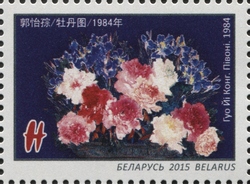Stamp: Nature motifs in Paintings of Belarus and China (Belarus 2015)
Nature motifs in Paintings of Belarus and China (Belarus 2015)
15 December (Belarus ) within release Nature motifs in Paintings of Belarus and China goes into circulation Stamp Nature motifs in Paintings of Belarus and China face value H
| Stamp Nature motifs in Paintings of Belarus and China in catalogues | |
|---|---|
| WADP Numbering System - WNS: | WAD:BY052.15 |
Stamp is horizontal format.
Also in the issue Nature motifs in Paintings of Belarus and China:
- Stamp - Nature motifs in Paintings of Belarus and China face value A;
- Stamp - Nature motifs in Paintings of Belarus and China face value N;
- Stamp - Nature motifs in Paintings of Belarus and China face value M;
- Stamp - Nature motifs in Paintings of Belarus and China face value M;
- Stamp - Nature motifs in Paintings of Belarus and China face value H;
- Stamp - Nature motifs in Paintings of Belarus and China face value P;
- Stamp - Valeriana Zholtok. Summer. 1977. face value A;
- Stamp - Gavriil Vashchenko. Flash of summer lightning. face value N;
- Stamp - Gennady Loyko. Aurochs. 1968. face value М;
- Stamp - Lui Da Wei. Bull. 2015 face value М;
- Stamp - Guo Yi Cong. Peonies. 1984 face value H;
- Stamp - Zhan Geng Xi. China crane. 2008 face value P;
- Souvenir Sheet - Nature motifs in paintings of Belarus and China face value None;
|
Data entry completed
76%
|
|
|---|---|
| Stamp Nature motifs in Paintings of Belarus and China in digits | |
| Country: | Belarus |
| Date: | 2015-12-15 |
| Size: | 38.18 x 28 |
| Perforation: | 12 by 12 |
| Format: | Stamp |
| Face Value: | H |
Stamp Nature motifs in Paintings of Belarus and China it reflects the thematic directions:
In European academic traditions, fine art is made primarily for aesthetics or creative expression, distinguishing it from decorative art or applied art, which also has to serve some practical function, such as pottery or most metalwork. In the aesthetic theories developed in the Italian Renaissance, the highest art was that which allowed the full expression and display of the artist's imagination, unrestricted by any of the practical considerations involved in, say, making and decorating a teapot. It was also considered important that making the artwork did not involve dividing the work between different individuals with specialized skills, as might be necessary with a piece of furniture, for example. Even within the fine arts, there was a hierarchy of genres based on the amount of creative imagination required, with history painting placed higher than still life.
Painting is the practice of applying paint, pigment, color or other medium to a solid surface (support base). The medium is commonly applied to the base with a brush, but other implements, such as knives, sponges, and airbrushes, can be used. Painting is a mode of creative expression, and the forms are numerous. Drawing, gesture (as in gestural painting), composition, narration (as in narrative art), or abstraction (as in abstract art), among other aesthetic modes, may serve to manifest the expressive and conceptual intention of the practitioner. Paintings can be naturalistic and representational (as in a still life or landscape painting), photographic, abstract, narrative, symbolistic (as in Symbolist art), emotive (as in Expressionism), or political in nature (as in Artivism). A portion of the history of painting in both Eastern and Western art is dominated by spiritual motifs and ideas. Examples of this kind of painting range from artwork depicting mythological figures on pottery, to Biblical scenes rendered on the interior walls and ceiling of the Sistine Chapel, to scenes from the life of Buddha or other images of Eastern religious origin. In art, the term painting describes both the act and the result of the action. The support for paintings includes such surfaces as walls, paper, canvas, wood, glass, lacquer, clay, leaf, copper and concrete, and the painting may incorporate multiple other materials including sand, clay, paper, plaster, gold leaf, as well as objects. The term painting is also used outside of art as a common trade among craftsmen and builders.


